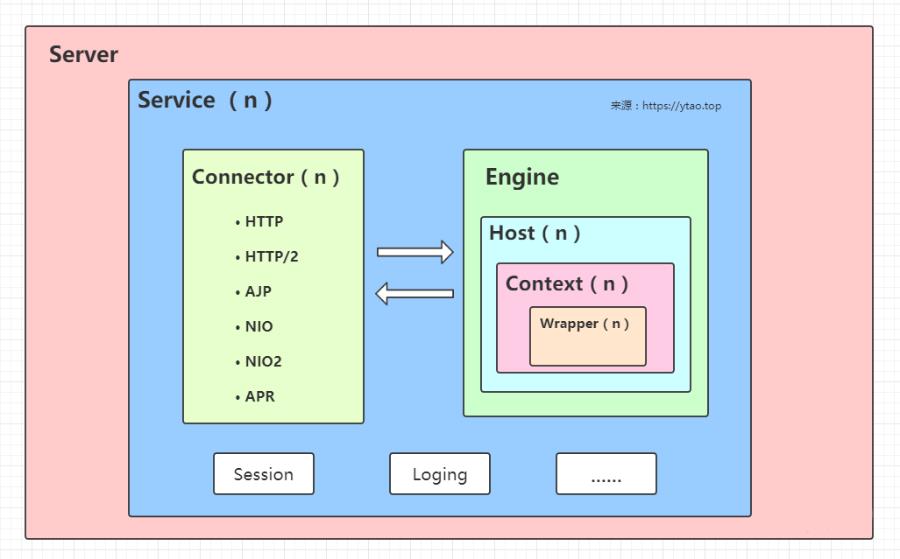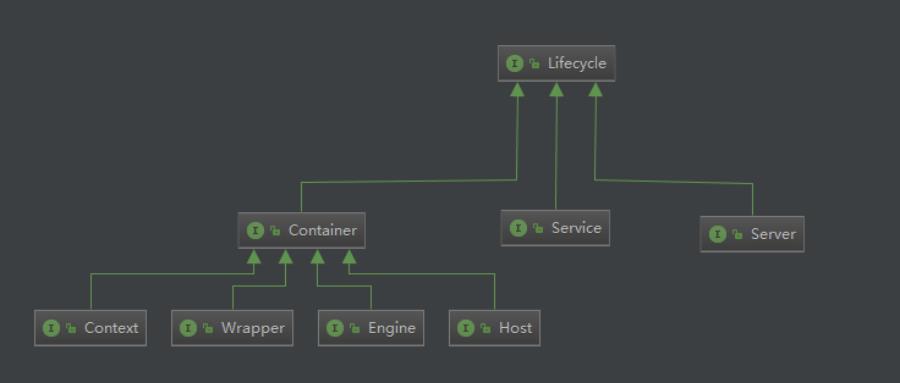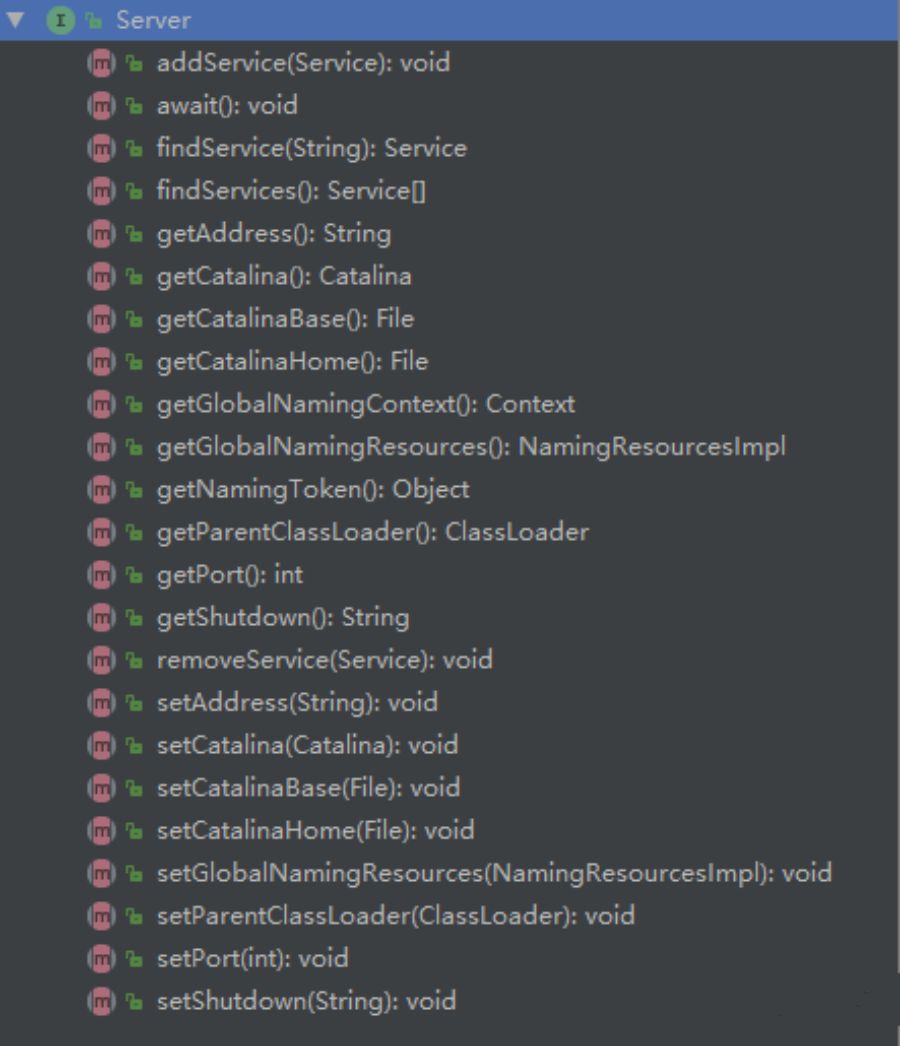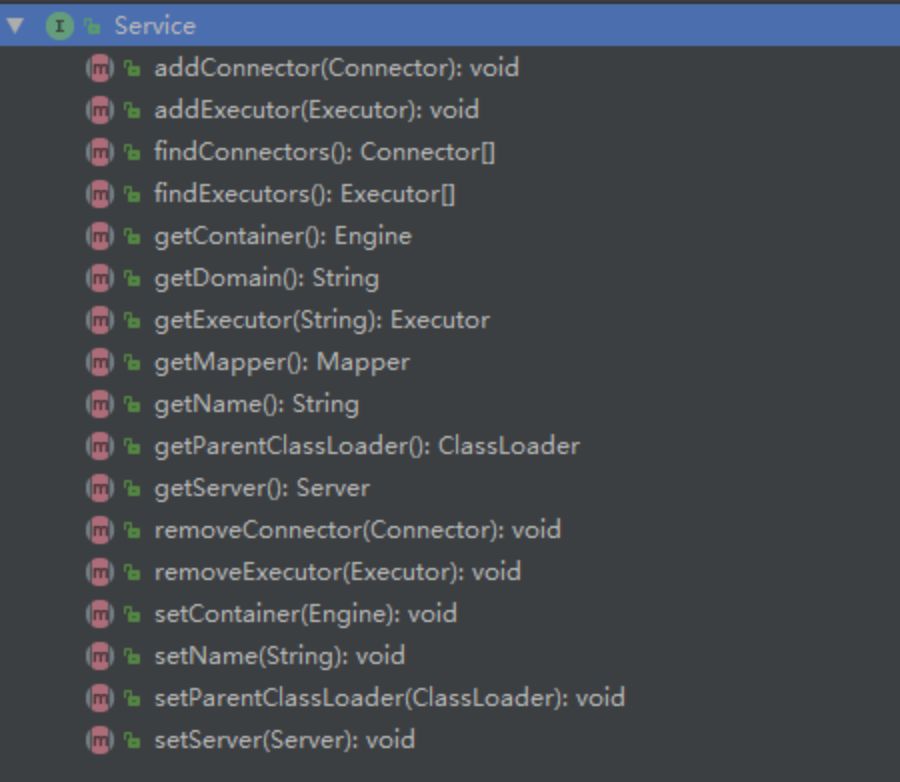初探Tomcat的架构设计
Posted 码农沉思录
tags:
篇首语:本文由小常识网(cha138.com)小编为大家整理,主要介绍了初探Tomcat的架构设计相关的知识,希望对你有一定的参考价值。
Tomcat 作为 servlet 容器实现,它是基于 Java 语言开发的轻量级应用服务器。因为 Tomcat 作为应用服务器,它有着完全开源,轻量,性能稳定,部署成本低等优点,所以它成为目前 Java 开发应用部署的首选,几乎每个Java Web开发者都有使用过,但是,你对 Tomcat 的整体设计有进行过了解和思考吗?
v8.5.49
总体结构
n代表该组件可允许存在多个。


backgroundProcess()方法,后台异步处理,所以继承它后可以方便的创建异步线程。在 Tomcat7 中,有看到 Service 持有的是 Container,而不是 Engine。估计这也是为什么在当前版本中添加 Engine 方法名叫
setContainer。
Server
org.apache.catalina.Server接口,对应的默认实现类为
org.apache.catalina.core.StandardServer,接口里面提供有如下图方法。


addService向定义的服务集添加新服务进行分析:
// 保存服务的服务集
privateService services[] = newService[0];
finalPropertyChangeSupport support = newPropertyChangeSupport(this);
@Override
publicvoid addService(Service service) {
// 相互关联
service.setServer(this);
// 利用同步锁,防止并发访问 来源:https://ytao.top
synchronized(servicesLock) {
Service results[] = newService[services.length + 1];
// copy 旧的服务到新的数组中
System.arraycopy(services, 0, results, 0, services.length);
// 添加新的 service
results[services.length] = service;
services = results;
// 如果当前 server 已经启动,那么当前添加的 service 就开始启动
if(getState().isAvailable()) {
try{
service.start();
} catch(LifecycleException e) {
// Ignore
}
}
// 使用观察者模式,当被监听对象属性值发生变化时通知监听器,remove 是也会调用。
support.firePropertyChange("service", null, service);
}
}
Service
org.apache.catalina.Service接口和默认实现类
org.apache.catalina.coreStandardService。

setContainer和
addConnector两个方法。
privateEngine engine = null;
protectedfinalMapperListener mapperListener = newMapperListener(this);
@Override
publicvoid setContainer(Engine engine) {
Engine oldEngine = this.engine;
// 判断当前 Service 是否有关联 Engine
if(oldEngine != null) {
// 如果当前 Service 有关联 Engine,就去掉当前关联的 Engine
oldEngine.setService(null);
}
// 如果当前新的 Engine 不为空,那么 Engine 关联当前 Service,这里是个双向关联
this.engine = engine;
if(this.engine != null) {
this.engine.setService(this);
}
// 如果当前 Service 启动了,那么就开始启动当前新的 Engine
if(getState().isAvailable()) {
if(this.engine != null) {
try{
this.engine.start();
} catch(LifecycleException e) {
log.error(sm.getString("standardService.engine.startFailed"), e);
}
}
// 重启 MapperListener ,获取一个新的 Engine ,一定是当前入参的 Engine
try{
mapperListener.stop();
} catch(LifecycleException e) {
log.error(sm.getString("standardService.mapperListener.stopFailed"), e);
}
try{
mapperListener.start();
} catch(LifecycleException e) {
log.error(sm.getString("standardService.mapperListener.startFailed"), e);
}
// 如果当前 Service 之前有 Engine 关联,那么停止之前的 Engine
if(oldEngine != null) {
try{
oldEngine.stop();
} catch(LifecycleException e) {
log.error(sm.getString("standardService.engine.stopFailed"), e);
}
}
}
// Report this property change to interested listeners
support.firePropertyChange("container", oldEngine, this.engine);
}
/**
* 实现方式和 StandardServer#addService 类似,不在细述
* 注意,Connector 这里没有像 Engine 一样与 Service 实现双向关联
*/
@Override
publicvoid addConnector(Connector connector) {
synchronized(connectorsLock) {
connector.setService(this);
Connector results[] = newConnector[connectors.length + 1];
System.arraycopy(connectors, 0, results, 0, connectors.length);
results[connectors.length] = connector;
connectors = results;
if(getState().isAvailable()) {
try{
connector.start();
} catch(LifecycleException e) {
log.error(sm.getString(
"standardService.connector.startFailed",
connector), e);
}
}
// Report this property change to interested listeners
support.firePropertyChange("connector", null, connector);
}
}
Connector
监听服务器端口来读取客户端的请求。
解析协议并交给对应的容器处理请求。
返回处理后的信息给客户端
<Connectorport="8080"protocol="HTTP/1.1"
connectionTimeout="20000"
redirectPort="8443"/>
port,指定处理协议
protocol,以及重定向地址
redirectPort。协议处理类型通过实例化连接器时设置:
publicConnector() {
// 无参构造,下面 setProtocol 中默认使用HTTP/1.1
this(null);
}
publicConnector(String protocol) {
// 设置当前连接器协议处理类型
setProtocol(protocol);
// 实例化协议处理器,并保存到当前 Connector 中
ProtocolHandler p = null;
try{
Class<?> clazz = Class.forName(protocolHandlerClassName);
p = (ProtocolHandler) clazz.getConstructor().newInstance();
} catch(Exception e) {
log.error(sm.getString(
"coyoteConnector.protocolHandlerInstantiationFailed"), e);
} finally{
this.protocolHandler = p;
}
if(Globals.STRICT_SERVLET_COMPLIANCE) {
uriCharset = StandardCharsets.ISO_8859_1;
} else{
uriCharset = StandardCharsets.UTF_8;
}
}
/**
* 这个设置再 tomcat9 中被移除,改为必配项
*/
publicvoid setProtocol(String protocol) {
boolean aprConnector = AprLifecycleListener.isAprAvailable() &&
AprLifecycleListener.getUseAprConnector();
// 这里指定了默认协议和 HTTP/1.1 一样
if("HTTP/1.1".equals(protocol) || protocol == null) {
if(aprConnector) {
setProtocolHandlerClassName("org.apache.coyote.http11.Http11AprProtocol");
} else{
setProtocolHandlerClassName("org.apache.coyote.http11.Http11NioProtocol");
}
} elseif("AJP/1.3".equals(protocol)) {
if(aprConnector) {
setProtocolHandlerClassName("org.apache.coyote.ajp.AjpAprProtocol");
} else{
setProtocolHandlerClassName("org.apache.coyote.ajp.AjpNioProtocol");
}
} else{
// 最后如果不是通过指定 HTTP/1.1,AJP/1.3 类型的协议,就通过类名实例化一个协议处理器
setProtocolHandlerClassName(protocol);
}
}
Engine
org.apache.catalina.Engine接口和
org.apache.catalina.core.StandardEngine默认实现类。Engine 的功能也比较简单,处理容器关系的关联。

addChild()不是指的子 Engine,而是只能是 Host。同时没有父容器,
setParent是不允许操作设置的。
@Override
publicvoid addChild(Container child) {
// 添加的子容器必须是 Host
if(!(child instanceofHost))
thrownewIllegalArgumentException
(sm.getString("standardEngine.notHost"));
super.addChild(child);
}
@Override
publicvoid setParent(Container container) {
thrownewIllegalArgumentException
(sm.getString("standardEngine.notParent"));
}
<!-- 配置默认Host,及jvmRoute -->
<Enginename="Catalina"defaultHost="localhost"jvmRoute="jvm1">
Host
<!-- name 设置的时虚拟主机域名 -->
<Hostname="localhost"appBase="webapps"
unpackWARs="true"autoDeploy="true">
Context
addChild方法,该添加的子容器是 Wrapper:
@Override
publicvoid addChild(Container child) {
// Global JspServlet
Wrapper oldJspServlet = null;
// 这里添加的子容器只能时 Wrapper
if(!(child instanceofWrapper)) {
thrownewIllegalArgumentException
(sm.getString("standardContext.notWrapper"));
}
// 判断子容器 Wrapper 是否为 JspServlet
boolean isJspServlet = "jsp".equals(child.getName());
// Allow webapp to override JspServlet inherited from global web.xml.
if(isJspServlet) {
oldJspServlet = (Wrapper) findChild("jsp");
if(oldJspServlet != null) {
removeChild(oldJspServlet);
}
}
super.addChild(child);
// 将servlet映射添加到Context组件
if(isJspServlet && oldJspServlet != null) {
/*
* The webapp-specific JspServlet inherits all the mappings
* specified in the global web.xml, and may add additional ones.
*/
String[] jspMappings = oldJspServlet.findMappings();
for(int i=0; jspMappings!=null&& i<jspMappings.length; i++) {
addServletMappingDecoded(jspMappings[i], child.getName());
}
}
}
Wrapper
publicsynchronizedServlet loadServlet() throwsServletException{
// 如果已经实例化或者用实例化池,就直接返回
if(!singleThreadModel && (instance != null))
return instance;
PrintStream out = System.out;
if(swallowOutput) {
SystemLogHandler.startCapture();
}
Servlet servlet;
try{
long t1=System.currentTimeMillis();
// 如果 servlet 类名为空,直接抛出 Servlet 异常
if(servletClass == null) {
unavailable(null);
thrownewServletException
(sm.getString("standardWrapper.notClass", getName()));
}
// 从 Context 中获取 Servlet
InstanceManager instanceManager = ((StandardContext)getParent()).getInstanceManager();
try{
servlet = (Servlet) instanceManager.newInstance(servletClass);
} catch(ClassCastException e) {
unavailable(null);
// Restore the context ClassLoader
thrownewServletException
(sm.getString("standardWrapper.notServlet", servletClass), e);
} catch(Throwable e) {
e = ExceptionUtils.unwrapInvocationTargetException(e);
ExceptionUtils.handleThrowable(e);
unavailable(null);
// Added extra log statement for Bugzilla 36630:
// https://bz.apache.org/bugzilla/show_bug.cgi?id=36630
if(log.isDebugEnabled()) {
log.debug(sm.getString("standardWrapper.instantiate", servletClass), e);
}
// Restore the context ClassLoader
thrownewServletException
(sm.getString("standardWrapper.instantiate", servletClass), e);
}
// 加载声明了 MultipartConfig 注解的信息
if(multipartConfigElement == null) {
MultipartConfig annotation =
servlet.getClass().getAnnotation(MultipartConfig.class);
if(annotation != null) {
multipartConfigElement =
newMultipartConfigElement(annotation);
}
}
// 对 servlet 类型进行检查
if(servlet instanceofContainerServlet) {
((ContainerServlet) servlet).setWrapper(this);
}
classLoadTime=(int) (System.currentTimeMillis() -t1);
if(servlet instanceofSingleThreadModel) {
if(instancePool == null) {
instancePool = newStack<>();
}
singleThreadModel = true;
}
// 初始化 servlet
initServlet(servlet);
fireContainerEvent("load", this);
loadTime=System.currentTimeMillis() -t1;
} finally{
if(swallowOutput) {
String log = SystemLogHandler.stopCapture();
if(log != null&& log.length() > 0) {
if(getServletContext() != null) {
getServletContext().log(log);
} else{
out.println(log);
}
}
}
}
return servlet;
}
到目前为止,大致介绍了 Tomcat8 的主要组件,对 Tomcat 的整体架构也有个大致了解了,Tomcat 源码进行重构后,可读性确实要好很多,建议大家可以去尝试分析下,里面的使用的一些设计模式,我们在实际编码过程中,还是有一定的借鉴意义。



以上是关于初探Tomcat的架构设计的主要内容,如果未能解决你的问题,请参考以下文章